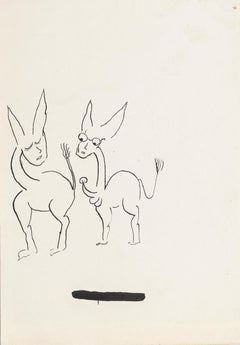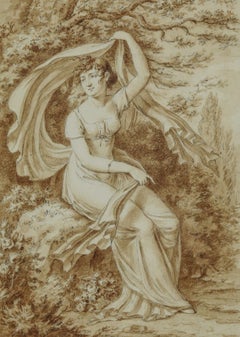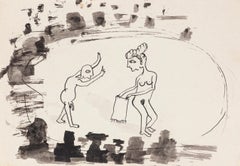Boris Ravitch Art
to
2
2
Overall Width
to
Overall Height
to
2
2
2
2
2
1
1
1
2
8,232
2,807
1,650
1,318
1
Artist: Boris Ravitch
Two Donkeys - China Ink Drawing by Boris Ravitch - Mid 20th Century
By Boris Ravitch
Located in Roma, IT
Two Donkeys is an original artwork realized in the first half of the XX Century in France by the artist Boris Ravitch.
Original watercolor china on paper.
Excellent conditions.
Category
Early 20th Century Boris Ravitch Art
Materials
Ink
Nude - Pen Drawing by Boris Ravitch - Mid 20th Century
By Boris Ravitch
Located in Roma, IT
Nude is an original work realized by the artist Boris Ravitch in the middle of the XX Century.
The work is realized in pen and is depicted on the back too.
On the back of the work...
Category
Early 20th Century Boris Ravitch Art
Materials
Pen
$270 Sale Price
25% Off
Related Items
Jean-Henri Cless (1774-1812) Portrait of a young woman, signed drawing
Located in Paris, FR
Jean-Henri Cless (1774-1812)
Portrait of a young woman in a landscape
signed "Cless fec" for fecit on the lower left
Brown ink and brown ink wash on paper
Size of the sheet : 31.5 x 22 cm
Size of the motive : 24.5 x 17 cm
very simply framed under glass without actual frame 32 x 22.5 cm
This pre...
Category
Early 1800s Old Masters Boris Ravitch Art
Materials
Ink, Pencil
"Indian Dance", Multicolor Abstract Geometric Composition
By Ellwood Graham
Located in Soquel, CA
Bright and colorful abstract geometric watercolor with multicolor connected forms cascading in a dynamic vertical composition by Ellwood Graham (American, 1911-2007). Signed "GRAHAM" in the upper right corner, and "Ellwood Graham" on verso. Circa 1961-1966. The title "Indian Dance...
Category
1960s Abstract Geometric Boris Ravitch Art
Materials
Paper, Watercolor, Pen, Pencil
$920 Sale Price
20% Off
H 29 in W 18.25 in D 0.5 in
Contemporary Drawing With Colored Pencils And Ink On Fabriano Paper. "Visions"
Located in Bogotá, Bogotá
Contemporary drawing work that combines the use of colored pencils and ink on a layer made with natural dyes from leaves and flowers. It is a surreal and fantastic drawing that seeks...
Category
2010s Contemporary Boris Ravitch Art
Materials
Paper, Ink, Color Pencil
Contemporary Drawing "Blue Prayer" Draw, Pastel, Ink And Colored Pencils
Located in Bogotá, Bogotá
Drawing, pastel, Pencil, Petal Flowers, Color and Ink on Paper.
The base of this drawing is ordinary yellow paper of 80 gr. I use natural dyes from flowers, herbs, leaves, and tree ...
Category
2010s Contemporary Boris Ravitch Art
Materials
Paper, Pastel, Ink, Pencil, Color Pencil
Two Nudes Figure Study
By Michael William Eggleston
Located in Soquel, CA
Figure study drawing with two nudes by Michael William Eggleston (American, 20th Century). Signed with the initials "MWE" in the lower right co...
Category
Late 20th Century American Realist Boris Ravitch Art
Materials
Paper, Gouache, Pen
$380 Sale Price
20% Off
H 21 in W 26 in D 0.07 in
Drawing, Acrylic, Ink And Colored Pencils On Paper. "Old love, new love"
Located in Bogotá, Bogotá
“Old love, new love” Drawing, acrylic, ink and colored pencils on paper. I developed a drawing technique based on natural pigments from leaves, flowers and bark with which I intend t...
Category
2010s Expressionist Boris Ravitch Art
Materials
Paper, Ink, Acrylic, Pencil, Color Pencil
Indian Warrior on Pale Blue Horse (Plains Indians Ledger Art) Blackfeet Nation
Located in Cody, WY
UNIQUE piece. TITLE: OUT FOR MORE. John Isaiah Pepion is a noted contemporary indigenous artist and renowned graphic ledger artist, muralist, and educator based on the Blackfeet Nati...
Category
2010s Tribal Boris Ravitch Art
Materials
Paper, Ink, Acrylic, Color Pencil
Mid-Century Modern Abstract Pen & Pencil Drawing by Taos Artist James Meek
By James Meek
Located in Denver, CO
This striking mid-century modern pen and pencil drawing by acclaimed Taos-based artist James Meek (b. 1928) features a bold geometric abstract composition that exemplifies his master...
Category
20th Century Pointillist Boris Ravitch Art
Materials
Mixed Media, Ballpoint Pen, Graphite
$1,950
H 25 in W 19.25 in D 1.5 in
"Peek A Boo" Rockwell-Inspired Painted Illustration in Framed Sketchbook
By Sean 9 Lugo
Located in Philadelphia, PA
"Peek A Boo" is an original piece by Sean 9 Lugo, known artistically for his murals and street art. The piece is part of Lugo's mounted "Blackbooks" series paying tribute to blackboo...
Category
21st Century and Contemporary Contemporary Boris Ravitch Art
Materials
Ink, Mixed Media, Acrylic, Paper, Found Objects, Permanent Marker
Winged Figure
By Lynn Chadwick
Located in Miami, FL
Lynn Chadwick (1914-2003)
Title: Winged Figure
Signed and dated 'Chadwick 68' (lower right)
Pen, ink, watercolor and pencil on paper
19 1/8” x 25 3/8” (48.5 x 64.5 cm)
Provenance: Sotheby's, London, 25 February 1987, lot 352; Alwin Galleries, London; Private Collection, U.K.
Lynn Chadwick (British, born November 24, 1914–died April 25, 2003) found international recognition when he became the youngest person ever to win the Venice Biennale’s prized sculptor award. His career spanned over 50 years, but he did not always plan on being an artist. He was born in London, and studied at the Merchant Taylor School in France. After moving back to England, he worked for several architects in London during the 1930s. Working as an architectural draughtsman helped Chadwick to hone his drawing and compositional skills. After serving in the British army during World War II, Chadwick returned to the architectural business, this time working with famed architect, Rodney Thomas.
While creating these transformative...
Category
1960s Contemporary Boris Ravitch Art
Materials
Pen, Watercolor, Ink
Louis Lesueur (1746-1803) Landscape with ruins, 1789, drawing signed and dated
Located in Paris, FR
Louis Lesueur (1746-1803)
A Fantasy Landscape with ancient ruins, 1789,
signed and dated "L Lesueur 1789" in the bottom centre
Pen and ink and ink wash on paper
14.8 x 22 cm
In goo...
Category
1780s Old Masters Boris Ravitch Art
Materials
Ink
$1,718
H 5.83 in W 8.67 in
Standing Nude - British 1946 exhibited art female portrait - Royal Academician
By Christopher Sanders
Located in London, GB
An original 1946 drawing painted by Royal Academy artist Christopher Sanders. A fine example of a Modern British nude drawing by an artist who exhibited hundreds of times at The Roya...
Category
20th Century Art Deco Boris Ravitch Art
Materials
Ink, Pen
$891 Sale Price
20% Off
H 20 in W 18 in D 2 in
Previously Available Items
Two Bullfight - China Ink Drawing by Boris Ravitch - Mid 20th Century
By Boris Ravitch
Located in Roma, IT
The Bullfight is an original contemporary artwork realized by the artist Boris Ravitch in the middle of the XX Century.
Original watercolored and china ink on paper.
Excellent con...
Category
Mid-20th Century Boris Ravitch Art
Materials
Ink
Boris Ravitch art for sale on 1stDibs.
Find a wide variety of authentic Boris Ravitch art available for sale on 1stDibs. You can also browse by medium to find art by Boris Ravitch in ink, pen and more. Not every interior allows for large Boris Ravitch art, so small editions measuring 7 inches across are available. Customers who are interested in this artist might also find the work of Vladimir Pavlovich Nechoumoff, Dmitrii Drugakov, and Ilya Shenker. Boris Ravitch art prices can differ depending upon medium, time period and other attributes. On 1stDibs, the price for these items starts at $334 and tops out at $446, while the average work can sell for $390.




